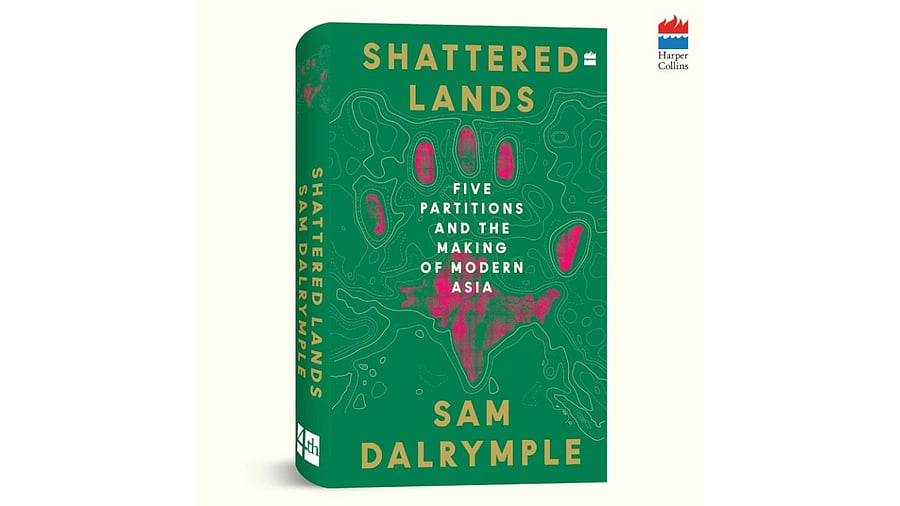
Shattered Lands
The bare bones of what this book deals with are conveyed by the six maps at the beginning, so one may be justified in wondering why one must plough through 485 pages (including endnotes) to understand the same. If borders drawn on paper alone told a story, it would undoubtedly be a stark tale of dissecting geographies, offering no clue about the human consequences of the ossification of these state boundaries and the havoc it would wreak on the affected populations.
Sam Dalrymple’s Shattered Lands is an epic account of the five partitions that divided the British Indian Empire into 12 nation-states, and the human drama which led to and resulted from these. It is a masterful narration of the political events that caused these partitions and their consequences. The research that has gone into the creation of this book is enormous in scope and satisfyingly deep, drawing on archival studies across nations and interviews in several languages.
However, all this research lies easy on the reader; Dalrymple’s prose is eminently readable and engages the reader effortlessly, leavening historical narrative with anecdotes and painstakingly gleaned insightful nuggets, which ensures one keeps turning the pages.
Shattered Lands appeals to our short-term amnesia about events in our (relatively) recent history. How many of us know that Aden and Oman were part of the Indian Empire assembled by the British less than a century ago? Or that Burma, too, was part of the Indian Empire till 1937? The word ‘partition’ brings to mind only the bloody ‘Great Partition of 1947’, which created India and Pakistan, and the yet-to-be-healed wound it inflicted, seared into our national consciousness.
Whereas we have forgotten the not-inconsiderable miseries of the Indians who fled post-partition Burma in 1942, in the wake of targeted violence. Other partitions which totally escape our historical memory are the separation of Aden in 1937 and the states of the Persian Gulf in April 1947.
Most Indians would be astounded to find Abu Dhabi heading the list of Princely States in the Appendix to the book, underlining the enormity of this forgetfulness.
Dalrymple also calls our attention to what he calls the ‘Partition of Princely India’. This might seem a matter of trifling detail, but, as the author states, “Much of the shape of modern India, Pakistan and Burma was actually determined by the decisions of the Indian princes, rather than British administrators, who chose to ‘integrate’ their kingdoms with one of the new countries, or become independent.” The last partition, of course, was the splitting of Pakistan and the birth of Bangladesh, which is familiar to all of us. In four decades, the British Empire, which stretched from Aden in the east to Burma in the west, was sliced into 12 independent nation states, and this is the story of these partitions — with all the intrigue, negotiations and conflict which led to them, and the subsequent fallouts from it.
What Shattered Lands compels us to do is to think of what constitutes modern nationhood and the identities of the constituent entities within a nation. Dalrymple quotes Partha Chatterji in the book, “The next time you are told about the timeless unity of the Indian nation, ask yourself why Nagaland is a part of India, but not Myanmar, why Sikkim is a part of India but not Nepal or Bhutan… [Then] you will begin to distinguish between the truths and lies of nationalism.”
When one looks at the larger entity, which was the Raj, whose disintegration is the theme of the book, one wonders whether some of the “largely forgotten” partitions that Dalrymple discusses remain forgotten because nobody mourns the loss of something which never was. The Raj in its entirety was nothing more than a clumsy agglomeration cobbled together to serve the coloniser’s interests. The Arabian and Burmese frontiers of the Raj, which he claims “were once central to the very idea of India”, have no relatable history older than colonisation.
Arguably, the same could be said of the “Undivided India” or “imagined Bharat” Dalrymple attributes to “Hindu nationalist imagination.”
The notion that modern India is a creation of the West is an often-parroted view. However, as Diana Eck, in her book India: A Sacred Geography, avers, “it is arresting to consider a ‘sense of unity’ construed in and through the imagined landscape [of India]…, a sense of connectedness that seemed to have flourished for many centuries without the need for overarching political expression or embodiment.”
Maybe it is time to move beyond the British Raj as the point of origin for the history of Indian nationhood, and seek answers in that “tremendous impress of oneness”, which Jawaharlal Nehru found in his travels across the nation, to the puzzle of how this behemoth of a nation works, despite all odds.
Indeed, the civilizational basis for India, which has a history older than even religion, might hold the key to understanding “India.”
(The reviewer is with the National Institute of Advanced Studies, Bengaluru.)